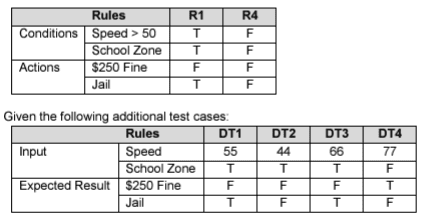ISTQB ISTQB-CTFL - ISTQB Certified Tester Foundation Level (CTFL v4.0)
A number of characteristics are given for impact of SDLC on the testing effort.
i. Finishing of requirements review leading to test analysis
ii. Both - static and dynamic testing performed at unit testing level
iii. Frequent regression testing may need to be performed
iv Extensive product documentation
v. More use of exploratory testing
Which of the following statements is MOST correct?
Which of the following statements about static testing and dynamic testing is TRUE?
Which of the following statements is NOT an objective of testing?
Which of the following is LEAST likely to describe a task performed by someone in a testing role?
Which of the following options should NOT be used for writing acceptance criteria?
Decision table testing is being performed on transactions in a bank’s ATM (Automated Teller Machine) system. Two test cases have already been generated for rules 1 and 4. which are shown below:

Which two of the additional test cases would achieve full coverage of the full decision table (when combined with the test cases that have already been generated for rules 1 and 4)?
Which of the following statements is true?
To be able to define testable acceptance criteria, specific topics need to be addressed. In the table below are the topics matched to an incorrect description. Match the topics (the left column) with the correct description (the right column)
TopicDescription
In which of the following test documents would you expect to find test exit criteria described9
In Agile teams, testers closely collaborate with all other team members. This close collaboration could be problematic and result in testing-related organizational risks.
Which TWO of the following organization risks could be encountered?
I.Testers lose motivation and fail at their core tasks.
ii.Close interaction with developers causes a loss of the appropriate tester mindset.
iii.Testers are not able to keep pace with incoming changes in time-constrained iterations.
iv.Testers, once they have acquired technical development or business skills, leave the testing team.



